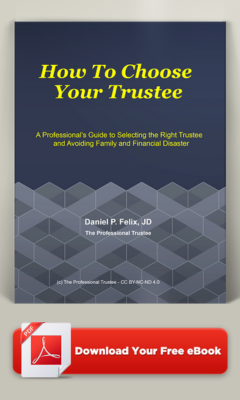The on-boarding process supports success by:
- Making sure the leadership and advisory roles are well-filled.
- Building an environment of mutual trust and collaboration.
- Setting, managing and meeting expectations of the stakeholder family and also advisors.
I’ve found that where I have followed an unsuccessful trustee, I have a better on-boarding. That’s because the stakeholders’ bad experience sets a foundational contrast with what needs to be done.
Where I’m stepping in after the settlor’s disability or death, I find successful on-boarding difficult without either (1) each family member having good counsel or even better (2) some pre-need preparedness.
The current typical practice is for a successor trustee to have little or no formal contact with the trust — or sometimes even with the family! — before the time arrives for him to formally step in.
However, trying to get up-to-speed in crisis challenges success, as does meeting the family for the first time at the trust maker’s funeral.
In contrast, many families and trusts benefit from the work of building structures and relationships in advance of need. This pre-need work can cover:
- Understanding exactly what happens and who the players will be during the trust maker’s disability and death.
- Understanding the trust’s provisions, and how life under the trust will be work.
- Setting foundations for what the trust and other documents typically don’t provide for:
- Goals for the trust and for the distributions as well as for the investments. Together these reveal what the assets will or won’t be used for in the critical context of how long they will last.
- Communication systems allowing the interested parties to stay informed.
- Being clear about what tasks and responsibilities the trustee will perform and what may or must the family or others take care of.
- Consensus on the fees and expenses of the trustee, including the factors, if any, which may increase or decrease those costs.
These are the daunting tasks of the family and trustee in preparing for trust administration. It’s a long technical list, and it is also as much a relational one. Given the foundation in family dynamics, the issues of how and why demand as much attention as the technical. And so, building a relationship of trust and respect is as important as legal and financial integrity. The one cannot move forward well without the other.
Variables will dictate much of the approach. These can include, but are no means limited to:
- The age and awareness of each of the family members. The sage advice applies in the trustscape: know your audience.
- Who has chosen the trustee. It makes a difference whether the trustee is a direct choice of the beneficiary, or of the trust maker, or of the court.
- Whether the trustee is already known to the family, including whether he’s a family member or an advisor who already enjoys a professional relationship with one or more of the family members. Too often those with pre-existing relationships squander the honey-moon effect by not setting a framework for the shift to the significantly different trustee role.
- The amount of money in the trust. And the value and type of other assets that may be in the trust matter as well.
- The needs and wants of the beneficiary.
- Whether the trust is designed to benefit more than one beneficiary.
Each scenario involves its own particular approach to move the family and trustee closer to success. Some may lend themselves to help from other professionals: experts in facilitation, mediation, and family relationships and dynamics, as well as the core of financial and legal advisors. Whatever the particulars, success in on-boarding requires active attention to the circumstances at hand.
Photo by paolo candelo on Unsplash© 2015 – 2023 Daniel P. Felix, all rights reserved.


